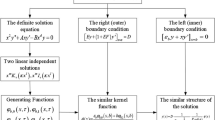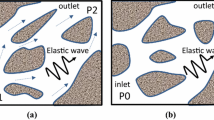Abstract
In analyzing the complex interaction between the wellbore and the reservoir formation, the hydromechanical properties of the region proximal to the wellbore, referred to as the “wellbore skin zone”, play a pivotal role in determining flow dynamics and the resulting formation deformation. Existing models of the wellbore skin zone generally assume a constant permeability throughout, resulting in a sharp permeability discontinuity at the skin-reservoir interface. This paper introduces a model for a wellbore with a continuously graded skin zone of finite thickness within a poroelastic medium. Analytical solutions are derived using the Laplace transform method, addressing both positive and negative skin zones. Numerical results are presented to illustrate the effects of graded permeability/skin zone thickness on pore pressures and stresses around a wellbore. The results highlight a distinct divergence in stress and pore pressure fields when comparing wellbores with negative skin zones to those with positive skin zones or no skin at all.





Similar content being viewed by others
References
Wang HF. Theory of linear poroelasticity. Princeton: Princeton University Press; 2000.
Huang C, Chen SL. Stress analysis of an inclined borehole subjected to fluid discharge in saturated transversely isotropic rocks. Int J Geomech. 2019;19(11):04019118.
Fan ZQ, Eichhubl P, Gale JFW. Geomechanical analysis of fluid injection and seismic fault slip for the M(w)4.8 Timpson, Texas, earthquake sequence. J Geophys Res-Solid Earth. 2016;121(4):2798–812.
Abousleiman YN, Chen SL. Poromechanics response of an inclined borehole subject to in-situ stress and finite length fluid discharge. J Mech Mater Struct. 2010;5(1):47–66.
Shi YF, Ma TS, Zhang DY, Chen YJ, Liu Y, Deng CS. Analytical model of wellbore stability analysis of inclined well based on the advantageous synergy among the five strength criteria. Geofluids. 2023;2023:2201870.
Cui L, Ekbote S, Abousleiman Y, Zaman M, Roegiers J. Borehole stability analysis in fluid saturated formations with impermeable boundary. Int J Rock Mech Min Sci. 1998;35(4/5):582–3.
He L-W, Jin Z-H. Convective cooling/heating induced thermal stresses in a fluid saturated porous medium undergoing local thermal non-equilibrium. Int J Solids Struct. 2012;49(5):748–58.
Gao J, Deng J, Lan K, Feng Y, Zhang W, Wang H. Porothermoelastic effect on wellbore stability in transversely isotropic medium subjected to local thermal non-equilibrium. Int J Rock Mech Min Sci. 2017;96:66–84.
Fan Z, Parashar R. Analytical solutions for a wellbore subjected to a non-isothermal fluid flux: implications for optimizing injection rates, fracture reactivation, and EGS hydraulic stimulation. Rock Mech Rock Eng. 2019;52(11):4715–29.
Ding L, Wang Z, Wang Y, Liu B. Thermo-poro-elastic analysis: the effects of anisotropic thermal and hydraulic conductivity on borehole stability in bedding formations. J Pet Sci Eng. 2020;190: 107051.
Fan Z, Eichhubl P, Newell P. Basement fault reactivation by fluid injection into sedimentary reservoirs: poroelastic effects. J Geophys Res-Solid Earth. 2019;124(7):7354–69.
Wang YL. Coupled THM formulation and wellbore analytical solution in naturally fractured media during injection/production. Adv Water Resour. 2023;178: 104492.
Huang C, Chen SL. Study of wellbore breakdown under fluid injection in transversely isotropic poroelastic formations. SPE J. 2021;26(1):394–411.
Fan ZQ, Parashar R, Jin ZH. Impact of convective cooling on pore pressure and stresses around a borehole subjected to a constant flux: implications for hydraulic tests in an enhanced geothermal system reservoir. Interpretation. 2020;8(2):SG13–20.
Rajapakse R. Stress analysis of borehole in poroelastic medium. J Eng Mech. 1993;119(6):1205–27.
Mehrabian A, Abousleiman YN. Generalized poroelastic wellbore problem. Int J Numer Anal Methods Geomech. 2013;37(16):2727–54.
Lin H, Deng J, Zhang X, Gao J. Porothermoelastic response of a borehole in fluid-saturated medium subjected to thermal osmosis effect. Geofluids. 2023;2023:4030804.
Zhai X, Atefi-Monfared K. Thermo-poroelasticity under temporal flux in low permeable layer confined with flexible sealing media. Int J Numer Anal Methods Geomech. 2021;45(3):382–410.
Bai B, Li T. Solutions for cylindrical cavity in saturated thermoporoelastic medium. Acta Mech Solida Sin. 2009;22(1):85–94.
Fan Z, Zhang C, Wang D, Li S, Zhao J, Wu Z. Thermoporoelastic response of a semi-permeable wellbore subjected to convective cooling and a non-hydrostatic stress. Int J Numer Anal Methods Geomech. 2023;47(11):2116–35.
Detournay E, Cheng AHD. Poroelastic response of a borehole in a non-hydrostatic stress field. Int J Rock Mech Min Sci. 1988;25(3):171–82.
Abousleliman Y, Ekbote S. Solutions for the inclined borehole in a porothermoelastic transversely isotropic medium. J Appl Mech. 2005;72(1):102–14.
Chen SL. Three-dimensional analytical poromechanical solutions for an arbitrarily inclined borehole subjected to fluid injection. Proc R Soc Lond Ser A. 2019;475:20180658.
Fan Z, Jin Z-H. Poroelastic Response of a Semi-Permeable Borehole Subjected to Non-Hydrostatic In Situ Stresses. J Appl Mech. 2023;90(7): 071001.
Yeh H-D, Chang YC. Recent advances in modeling of well hydraulics. Adv Water Resour. 2013;51:27–51.
Fan Z, Parashar R. Transient flow to a finite-radius well with wellbore storage and skin effect in a poroelastic confined aquifer. Adv Water Resour. 2020;142: 103604.
Butler JJ Jr. Pumping tests in nonuniform aquifers—the radially symmetric case. J Hydrol. 1988;101:15–30.
Novakowski KS. A composite analytical model for analysis of pumping tests affected by well bore storage and finite thickness skin. Water Resour Res. 1989;25:1937–46.
Sladek J, Sladek V, Schanz M. The MLPG applied to porous materials with variable stiffness and permeability. Meccanica. 2014;49(10):2359–73.
Tan YQ, Smith JV, Li CQ, Currell M, Wu YF. Predicting external water pressure and cracking of a tunnel lining by measuring water inflow rate. Tunn Undergr Space Technol. 2018;71:115–25.
Cheng AH-D. Poroelasticity. vol. 27. Theory and Applications of Transport in Porous Media. Berlin: Springer;2016.
Abousleiman Y, Cui L. Poroelastic solutions in transversely isotropic media for wellbore and cylinder. Int J Solids Struct. 1998;35(34–35):4905–29.
Fan Z, Zhao J, Wang D, Yue F, Wu Z, Xue R. Effects of local thermal non-equilibrium on hydraulic stimulation efficiency of enhanced geothermal systems. Geomech Geophys Geo-Energy Geo-Resour. 2024;10(1):47.
Funding
The first author acknowledges the financial support from Shaanxi Key Research and Development Program under Grant No. 2023-YBGY-058 and the Fundamental Research Funds for the Central Universities under Grant No. G2020KY05312.
Author information
Authors and Affiliations
Corresponding authors
Ethics declarations
Conflict of interests
The authors declare that they have no conflict of interest.
Rights and permissions
Springer Nature or its licensor (e.g. a society or other partner) holds exclusive rights to this article under a publishing agreement with the author(s) or other rightsholder(s); author self-archiving of the accepted manuscript version of this article is solely governed by the terms of such publishing agreement and applicable law.
About this article
Cite this article
Fan, Z., Jin, Z. Semi-analytical Solutions for Wellbores with Graded Skin Zones in Poroelastic Media. Acta Mech. Solida Sin. (2024). https://doi.org/10.1007/s10338-024-00487-3
Received:
Revised:
Accepted:
Published:
DOI: https://doi.org/10.1007/s10338-024-00487-3




